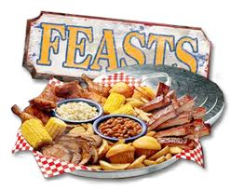 Of course, life has many daily challenges, and sometimes it may seem that there is very little to savor in our daily existence. But with a little perspective, some distance, and even an attitude adjustment, it can be clear that while there are tough moments in every day and in every life, there are also moments to treasure. Members of the Children’s Literature and Reading Special Interest Group explore recent titles whose characters embrace life fully or busily search for ingredients to insure that life is a feast.
Of course, life has many daily challenges, and sometimes it may seem that there is very little to savor in our daily existence. But with a little perspective, some distance, and even an attitude adjustment, it can be clear that while there are tough moments in every day and in every life, there are also moments to treasure. Members of the Children’s Literature and Reading Special Interest Group explore recent titles whose characters embrace life fully or busily search for ingredients to insure that life is a feast.
Sometimes holidays such as Thanksgiving provide the perfect time for those feasts, but often, ordinary days and meals can also turn into celebrations. ReadWriteThink offers a variety of lesson ideas on the Thanksgiving holiday. Some of these include “Myth and Truth: The First Thanksgiving;” “Packing the Pilgrim’s Trunk: Personalizing History in the Elementary Classroom;” or “Spend a Day in My Shoes.”
GRADES K-3
Child, Lydia Maria. (2013). Over the river and through the wood: The New England boy’s song about Thanksgiving. Illus. by Matt Tavares. Somerville, MA: Candlewick Press.
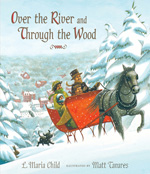
Newly formatted from the 2011 edition, this traditional song/poem returns for young readers. The words are the same as the horse and sleigh are ready to plow through the drifted snow all the way to Grandfather’s house. Matt Tavares’ illustrations add the warmth and charm of the old traditions associated with Thanksgiving. Matt Tavares has a short video showing the illustration process for this book on his website.
– Karen Hildebrand, Ohio Library and Reading Consultant
Cleland, Joann. (2013). Fabulous food. Vero Beach, FL: Rourke Educational Media.
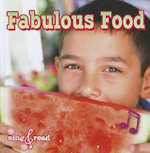
For the youngest reader or story time, the text of this book can be sung to “The Farmer in the Dell.” Learning about healthy foods, food groups, healthy teeth and bodies is the focus for young children as they are developing habits about food choices. Simple text and photographs add to the appeal. The inside front and back covers offer suggestions to teachers and parents.
– Karen Hildebrand, Ohio Library and Reading Consultant
Crum, Shutta. (2013). Dozens of cousins. Illus. by David Catrow. New York: Clarion Books.
 Although this book is actually about family reunions in warm weather, as we enter the time of year for family gatherings, this story will be fun to share with young readers. As all the cousins descend on the family’s gathering place, the wild “rumpus” begins, from jumping in the creek, climbing trees, daring each other to physical feats, and enjoying all the food that is at hand, piled on tables nearby. The adults, the babies, and the family dog are all in attendance and enjoy all the activity. Paired with Cynthia Rylant’s The Relatives Came (1993), this book will have young readers looking for similarities and differences between the two books. Exhausted at the end of the day, everyone drops and finds a place to sleep. Catrow’s illustrations add to the merriment, so look closely at all the enjoyable characters and reactions on the cousins and older relative’s faces. Enjoy this short video book trailer to introduce the book. Author Shutta Crum has made available a CCSS Teacher’s Guide for the book on her website/blog.
Although this book is actually about family reunions in warm weather, as we enter the time of year for family gatherings, this story will be fun to share with young readers. As all the cousins descend on the family’s gathering place, the wild “rumpus” begins, from jumping in the creek, climbing trees, daring each other to physical feats, and enjoying all the food that is at hand, piled on tables nearby. The adults, the babies, and the family dog are all in attendance and enjoy all the activity. Paired with Cynthia Rylant’s The Relatives Came (1993), this book will have young readers looking for similarities and differences between the two books. Exhausted at the end of the day, everyone drops and finds a place to sleep. Catrow’s illustrations add to the merriment, so look closely at all the enjoyable characters and reactions on the cousins and older relative’s faces. Enjoy this short video book trailer to introduce the book. Author Shutta Crum has made available a CCSS Teacher’s Guide for the book on her website/blog.
– Karen Hildebrand, Ohio Library and Reading Consultant
Elliott, Laura Malone. (2013). Thanksgiving Day thanks. Illus. by Lynn Munsinger. New York: Katherine Tegen Books/ HarperCollins.
 Returning from their adventure in A String of Hearts (2010), characters Sam, MaryAnn, Elliott and others are now getting ready for Thanksgiving. Mrs. Wright, teacher bear, has posed the question, “What one special thing about the holiday would you give thanks for?” The student bears come up with lots of things they like and enjoy, but Sam is having trouble sorting out his answer. Mrs. Wright goes on to get the class ready for their class project and celebration to learn more about the holiday. Still stumped, Sam and the class busy themselves in getting ready. Finally, Sam comes up with an idea, but he is not sure that it will work. He wants to make balloons and recreate a Macy’s-Day-Parade-style big balloon surprise! Fortunately, MaryAnn has become rather skilled at bow and arrows and saves the day…and the balloons! Author and illustrator have sprinkled a number of craft and Thanksgiving information and ideas throughout the story. Teachers will appreciate the sheet of Fun Facts that the author and illustrator have provided at the publisher’s website.
Returning from their adventure in A String of Hearts (2010), characters Sam, MaryAnn, Elliott and others are now getting ready for Thanksgiving. Mrs. Wright, teacher bear, has posed the question, “What one special thing about the holiday would you give thanks for?” The student bears come up with lots of things they like and enjoy, but Sam is having trouble sorting out his answer. Mrs. Wright goes on to get the class ready for their class project and celebration to learn more about the holiday. Still stumped, Sam and the class busy themselves in getting ready. Finally, Sam comes up with an idea, but he is not sure that it will work. He wants to make balloons and recreate a Macy’s-Day-Parade-style big balloon surprise! Fortunately, MaryAnn has become rather skilled at bow and arrows and saves the day…and the balloons! Author and illustrator have sprinkled a number of craft and Thanksgiving information and ideas throughout the story. Teachers will appreciate the sheet of Fun Facts that the author and illustrator have provided at the publisher’s website.
– Karen Hildebrand, Ohio Library and Reading Consultant
Kunhardt, Dorothy. (2013). Junket is nice. New York: NYR Children’s Collection. (1932, 1961)
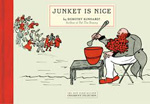 Step back into the early world of books for children. Though most people will remember Dorothy Kunhardt for her bestselling, Pat the Bunny, The New York Review Children’s Collection has brought back her first book, Junket Is Nice, first published in 1932. To go along with the feasts and food theme this week, young readers will enjoy hearing the story of the old man with a long red beard and red slippers eating from his huge red bowl his very favorite food, junket. What is junket? The story itself does not tell you, but the publisher says that it is a delicious custard dessert. The story continues with the old man eating and eating his junket as people begin to gather and eventually come from all over the world to watch him eat. He poses a question to the now enormous crowd to ask if they can guess what he is thinking about? After many, many tries, a little boy on a tricycle answers correctly. For his prize in guessing the right answer, the old man allows the young boy to lick the bowl clean. This visit from the children’s literature past will make for a very fun read aloud.
Step back into the early world of books for children. Though most people will remember Dorothy Kunhardt for her bestselling, Pat the Bunny, The New York Review Children’s Collection has brought back her first book, Junket Is Nice, first published in 1932. To go along with the feasts and food theme this week, young readers will enjoy hearing the story of the old man with a long red beard and red slippers eating from his huge red bowl his very favorite food, junket. What is junket? The story itself does not tell you, but the publisher says that it is a delicious custard dessert. The story continues with the old man eating and eating his junket as people begin to gather and eventually come from all over the world to watch him eat. He poses a question to the now enormous crowd to ask if they can guess what he is thinking about? After many, many tries, a little boy on a tricycle answers correctly. For his prize in guessing the right answer, the old man allows the young boy to lick the bowl clean. This visit from the children’s literature past will make for a very fun read aloud.
– Karen Hildebrand, Ohio Library and Reading Consultant
LaRochelle, David. (2013). How Martha saved her parents from green beans. Illus. by Mark Fearing. New York: Dial Books.
 As holiday feasts approach, green bean casserole is often a family favorite. But do kids like it? Here is a tremendously funny story about young Martha, who, like many children, hates green beans. Every Tuesday night for supper, her mother serves green beans, and every Tuesday Martha refuses to eat them and says green beans are “bad!” One day, a mob of tough-looking, angry green beans come to town and kidnap Martha’s parents. At first, Martha thinks this is great as she tosses her veggies out the window, but she soon comes to the realization that she misses her parents. The beans have been creating havoc in town, too. Martha finds her parents tied to a rock outside a cave. She insists that the beans return her parents, but they snicker and refuse. Her only thought to save her parents is to eat (ugh!) the beans. They aren’t afraid because they know she has never eaten a green bean in her life. Holding her nose, she grabs a bean and then another and another until they are all gone! Hear this book read aloud from Liz’s Book Snuggery, and read more from author David LaRochelle in his Teaching Tip “Moo. Moo? Moo! Writing a Single Word Story.”
As holiday feasts approach, green bean casserole is often a family favorite. But do kids like it? Here is a tremendously funny story about young Martha, who, like many children, hates green beans. Every Tuesday night for supper, her mother serves green beans, and every Tuesday Martha refuses to eat them and says green beans are “bad!” One day, a mob of tough-looking, angry green beans come to town and kidnap Martha’s parents. At first, Martha thinks this is great as she tosses her veggies out the window, but she soon comes to the realization that she misses her parents. The beans have been creating havoc in town, too. Martha finds her parents tied to a rock outside a cave. She insists that the beans return her parents, but they snicker and refuse. Her only thought to save her parents is to eat (ugh!) the beans. They aren’t afraid because they know she has never eaten a green bean in her life. Holding her nose, she grabs a bean and then another and another until they are all gone! Hear this book read aloud from Liz’s Book Snuggery, and read more from author David LaRochelle in his Teaching Tip “Moo. Moo? Moo! Writing a Single Word Story.”
– Karen Hildebrand, Ohio Library and Reading Consultant
Lin, Grace. (2013). Ling & Ting share a birthday. New York: Little, Brown Books for Young Readers.
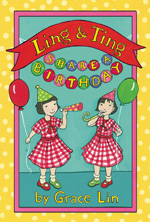 Early readers who enjoyed this book’s predecessor, Ling & Ting: Not Exactly the Same (Little Brown, 2010) will find its sequel every bit as charming. Almost look-alike twin sisters Ling and Ting are similar in many ways, and yet each one is unique as this book makes clear. The book is organized around six birthday-related short stories. When the girls receive birthday shoes, one pair green, the other red, they share them so each one has a green and a red shoe. Over the course of the book, they also shop for presents, bake birthday cakes, make wishes as they blow out candles, and open the presents each bought for the other. The presents are exactly what the giver, if not the recipient, wanted. Finally, they read a birthday story similar to their own but different enough to make them content with their own identities. While brief, each story contains an example revealing how different the girls are. The gouache illustrations highlight the emotion and mischief in both girls' eyes. While they may share a birthday, there are clearly many talents such as baking that they do not share.
Early readers who enjoyed this book’s predecessor, Ling & Ting: Not Exactly the Same (Little Brown, 2010) will find its sequel every bit as charming. Almost look-alike twin sisters Ling and Ting are similar in many ways, and yet each one is unique as this book makes clear. The book is organized around six birthday-related short stories. When the girls receive birthday shoes, one pair green, the other red, they share them so each one has a green and a red shoe. Over the course of the book, they also shop for presents, bake birthday cakes, make wishes as they blow out candles, and open the presents each bought for the other. The presents are exactly what the giver, if not the recipient, wanted. Finally, they read a birthday story similar to their own but different enough to make them content with their own identities. While brief, each story contains an example revealing how different the girls are. The gouache illustrations highlight the emotion and mischief in both girls' eyes. While they may share a birthday, there are clearly many talents such as baking that they do not share.
– Barbara A. Ward, Washington State University Pullman
Reynolds, Aaron. (2013). Carnivores. Illus. by Dan Santat. San Francisco, CA: Chronicle Books.
 A great white shark, a timber wolf, and a lion represent the top of the food chain and are meat-eaters, i.e. carnivores. They are in despair that they have been given such a bad rap for their meat-eating diet. They are depressed and trying to convince themselves, and others, that they can become vegetarians. They put on disguises in an attempt to change. However, nothing is really working until they seek the advice of a great horned owl, their carnivore consultant. The owl tells them that being carnivores is what they are meant to be and meat is the right food for them to eat. This is what they are supposed to be eating. The trio brighten with this advice and cheer up and enjoy going back to who they really are. Santat’s comic illustrations and the facial expressions on all the animal characters are hilarious and set the humorous tone for the book. The underlying theme for young readers, of course, is being yourself and accepting who you are. Teachers will appreciate the detailed activity kit at the publisher’s website or enjoy a fun book trailer at YouTube.
A great white shark, a timber wolf, and a lion represent the top of the food chain and are meat-eaters, i.e. carnivores. They are in despair that they have been given such a bad rap for their meat-eating diet. They are depressed and trying to convince themselves, and others, that they can become vegetarians. They put on disguises in an attempt to change. However, nothing is really working until they seek the advice of a great horned owl, their carnivore consultant. The owl tells them that being carnivores is what they are meant to be and meat is the right food for them to eat. This is what they are supposed to be eating. The trio brighten with this advice and cheer up and enjoy going back to who they really are. Santat’s comic illustrations and the facial expressions on all the animal characters are hilarious and set the humorous tone for the book. The underlying theme for young readers, of course, is being yourself and accepting who you are. Teachers will appreciate the detailed activity kit at the publisher’s website or enjoy a fun book trailer at YouTube.
– Karen Hildebrand, Ohio Library and Reading Consultant
Thomson, Sarah L. (2013). Cub's big world. Illus. by Joe Cepeda. Boston: Houghton Mifflin Harcourt Books for Young Readers.
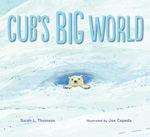 The wide world is Cub’s playground once he and his mother leave the den. Since a polar bear cub knows only the den in which he and his mother have lived for so long, he was perfectly content to live there. But once she brings him from their den to explore the world outside their winter home, he notices new colors and gradually explores the wider world. Separated from his mother, he knows that he must look for her distinctive features. There’s a lot of white in the Arctic so he chases anything black since he knows her black nose will stand out against the snow's white. The cub follows a raven, an ermine, and a seal, all of whom have black parts that fool the cub into thinking he's found his mother. Each time, though, he is disappointed that he has been fooled. Not only is the book a beautiful tribute to arctic animals and familial love, but it also celebrates the joys of starting to spread one's wings and learn about the wider world. The oil and acrylic illustrations in this picture book are quite lovely and allow readers to pay attention to Cub's icy world. As long as Cub’s mom is not far away, he can explore as much as he wants and allow the world he knows to expand.
The wide world is Cub’s playground once he and his mother leave the den. Since a polar bear cub knows only the den in which he and his mother have lived for so long, he was perfectly content to live there. But once she brings him from their den to explore the world outside their winter home, he notices new colors and gradually explores the wider world. Separated from his mother, he knows that he must look for her distinctive features. There’s a lot of white in the Arctic so he chases anything black since he knows her black nose will stand out against the snow's white. The cub follows a raven, an ermine, and a seal, all of whom have black parts that fool the cub into thinking he's found his mother. Each time, though, he is disappointed that he has been fooled. Not only is the book a beautiful tribute to arctic animals and familial love, but it also celebrates the joys of starting to spread one's wings and learn about the wider world. The oil and acrylic illustrations in this picture book are quite lovely and allow readers to pay attention to Cub's icy world. As long as Cub’s mom is not far away, he can explore as much as he wants and allow the world he knows to expand.
– Barbara A. Ward, Washington State University Pullman
Twohy, Mike. (2013). Outfoxed. New York: Simon & Schuster.
 Even the most cold-hearted among us would agree that even foxes need to eat. Under the cover of night, a hungry fox slips into a nearby henhouse and snatches what he thinks will be the main ingredient in a succulent chicken feast. Once he arrives home, he realizes that he has the wrong bird. Although he has stolen a duck instead of a chicken, he decides to make do with what he has. The desperate duck cleverly decides to mimic a dog, an animal the fox certainly won’t eat. As he outfoxes the fox by behaving like a dog, there is much tail wagging, slobbering, and barking. Eventually, the fox has had enough love, especially after being woken with a lick on his face, and returns the duck to his farm home. Only after he returns home to find the egg the duck left behind does he realize his mistake. Young readers will chortle as they read this simple, humorous story embellished with illustrations created with markers and colored pencils. It looks as though the only feast this fox will have will be one involving eggs or perhaps some well-gnawed socks.
Even the most cold-hearted among us would agree that even foxes need to eat. Under the cover of night, a hungry fox slips into a nearby henhouse and snatches what he thinks will be the main ingredient in a succulent chicken feast. Once he arrives home, he realizes that he has the wrong bird. Although he has stolen a duck instead of a chicken, he decides to make do with what he has. The desperate duck cleverly decides to mimic a dog, an animal the fox certainly won’t eat. As he outfoxes the fox by behaving like a dog, there is much tail wagging, slobbering, and barking. Eventually, the fox has had enough love, especially after being woken with a lick on his face, and returns the duck to his farm home. Only after he returns home to find the egg the duck left behind does he realize his mistake. Young readers will chortle as they read this simple, humorous story embellished with illustrations created with markers and colored pencils. It looks as though the only feast this fox will have will be one involving eggs or perhaps some well-gnawed socks.
– Barbara A. Ward, Washington State University Pullman
Willems, Mo. (2013). That is not a good idea! New York: HarperCollins/Balzer + Bray.
 When a wolf and a goose spot each other along the busy city streets, they only have eyes for one another. The wolf suggests that the two of them take a leisurely stroll and then have dinner. The goose simpers from all the attention, and the wolf salivates in anticipation. Readers familiar with the behavior of wily, hungry wolves from previous folktales will be certain that the goose should not agree to his plans, a notion that is supported by the bright yellow baby birds that keep telling readers that each of the moves made by the animal characters is not a good idea. Once the would-be couple reaches the wolf’s place and the soup is simmering, the story’s tension is heightened. Readers will be certain that the gullible goose is doomed and is about to be added to the soup. But it turns out all those cautionary words were not for her, after all. Young readers (and their parents) are sure to enjoy this slightly twisted tale and the pencil and watercolor illustrations that have been embellished with digital color. The blush on the goose's face, the hunger on the wolf's visage, and those hyperactive chicks offering their own advice all add to the delight of reading this one, which is, of course, a perfect read aloud title.
When a wolf and a goose spot each other along the busy city streets, they only have eyes for one another. The wolf suggests that the two of them take a leisurely stroll and then have dinner. The goose simpers from all the attention, and the wolf salivates in anticipation. Readers familiar with the behavior of wily, hungry wolves from previous folktales will be certain that the goose should not agree to his plans, a notion that is supported by the bright yellow baby birds that keep telling readers that each of the moves made by the animal characters is not a good idea. Once the would-be couple reaches the wolf’s place and the soup is simmering, the story’s tension is heightened. Readers will be certain that the gullible goose is doomed and is about to be added to the soup. But it turns out all those cautionary words were not for her, after all. Young readers (and their parents) are sure to enjoy this slightly twisted tale and the pencil and watercolor illustrations that have been embellished with digital color. The blush on the goose's face, the hunger on the wolf's visage, and those hyperactive chicks offering their own advice all add to the delight of reading this one, which is, of course, a perfect read aloud title.
– Barbara A. Ward, Washington State University Pullman
GRADES 4-6
Appelt, Kathi. (2013). The true blue scouts of Sugar Man Swamp. Illus. by Jennifer Bricking. New York: Atheneum Books for Young Readers.
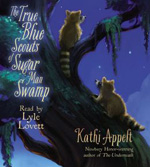 Any reader who has never tasted fried sugar pies will suddenly experience an odd craving for these delicacies while reading this delicious tall tale set in the Louisiana swamps. The short chapters allow this gifted storyteller to introduce different animal and human characters while shifting occasionally back and forth in time. As twelve-year-old Chap Brayburn mourns the loss of his bird-loving grandfather, Audie, he and his mother look for ways to thwart wealthy Sonny Boy Beaucoup's plans to commercialize the swamp by promoting a female alligator wrestler.
Any reader who has never tasted fried sugar pies will suddenly experience an odd craving for these delicacies while reading this delicious tall tale set in the Louisiana swamps. The short chapters allow this gifted storyteller to introduce different animal and human characters while shifting occasionally back and forth in time. As twelve-year-old Chap Brayburn mourns the loss of his bird-loving grandfather, Audie, he and his mother look for ways to thwart wealthy Sonny Boy Beaucoup's plans to commercialize the swamp by promoting a female alligator wrestler.
The loss of the swamp means much more than a loss of the family's fried sugar pie business. It also spells the end to Chap's dreams that someday the ivory-billed woodpeckers that once called that particular area of the country home might return. Bingo and J'miah are two raccoon brothers responsible for keeping an eye out for possible threats to the swamp. They hang out in an abandoned Desoto in the swamp and look for signs of coming disaster. When they realize a family of destructive feral hogs with a taste for the sugar cane that grows in the swamp is heading their way, they must awaken the Sugar Man so he can deal with the intruders. There are so many things happening in this book and so many wonderful characters that words hardly do it justice. Although there are many humorous moments and coincidences in this voice-filled book, ultimately, readers reach the conclusion hoping that maybe, just maybe, the Sugar Man and the Lord God bird are still out there in paradise in a place where raccoons climb to the tops of trees to wish on twinkling stars, and everything turns out just the way it should. Almost every page tugs at readers’ heartstrings.
– Barbara A. Ward, Washington State University Pullman
Cheng, Andrea. (2013). The year of the baby. Illus. by Patrice Barton. Boston: Houghton Mifflin Harcourt Books for Young Readers.
 Fifth grader Anna Wang worries about the baby her family has adopted from China since the child seems to have little appetite for the American and traditional Chinese food the family serves. She and her friends, Laura and Camille, design a science experiment to determine the effects their singing of songs in Chinese and English will have on how much Kaylee, her baby sister, eats. Like its predecessor, The Year of the Book (Houghton Mifflin Harcourt, 2012), this title contains some words and phrases in Chinese, a recipe, and incidents that are humorous and heart-warming. Perhaps most impressive is Anna’s steadfast determination to plot her own path and avoid following the crowd. Even when her classmates try to persuade her to join their science project group, which would make the assignment easier, she sticks to her own plans. The incidents described here and the pen and ink and digitally colored illustrations are exquisitely true to life, adding to Anna's unique charm. Readers will be drawn into the story and find themselves thinking of foods that might tempt Kaylee.
Fifth grader Anna Wang worries about the baby her family has adopted from China since the child seems to have little appetite for the American and traditional Chinese food the family serves. She and her friends, Laura and Camille, design a science experiment to determine the effects their singing of songs in Chinese and English will have on how much Kaylee, her baby sister, eats. Like its predecessor, The Year of the Book (Houghton Mifflin Harcourt, 2012), this title contains some words and phrases in Chinese, a recipe, and incidents that are humorous and heart-warming. Perhaps most impressive is Anna’s steadfast determination to plot her own path and avoid following the crowd. Even when her classmates try to persuade her to join their science project group, which would make the assignment easier, she sticks to her own plans. The incidents described here and the pen and ink and digitally colored illustrations are exquisitely true to life, adding to Anna's unique charm. Readers will be drawn into the story and find themselves thinking of foods that might tempt Kaylee.
– Barbara A. Ward, Washington State University Pullman
Cooper, Ilene. (2013). Thanks to Lucy. Illus. by David Merrell. New York: Random House.
 Bobby Quinn is anxiously awaiting several things —his grandmother’s visit for Thanksgiving and the arrival of his newly adopted brother or sister. This is number six in the Stepping Stone series about Bobby and his beloved beagle, Lucy. As the holiday, the baby and his grandmother are approaching; Bobby begins to notice that Lucy is not acting like her old self. Perhaps all the things being anticipated are causing Lucy problems, too.
Bobby Quinn is anxiously awaiting several things —his grandmother’s visit for Thanksgiving and the arrival of his newly adopted brother or sister. This is number six in the Stepping Stone series about Bobby and his beloved beagle, Lucy. As the holiday, the baby and his grandmother are approaching; Bobby begins to notice that Lucy is not acting like her old self. Perhaps all the things being anticipated are causing Lucy problems, too.
– Karen Hildebrand, Ohio Library and Reading Consultant
Giving thanks: Poems, prayers, and praise songs of Thanksgiving. (2013). Edited with reflections by Katherine Paterson. Illus. by Pamela Dalton. San Francisco: Chronicle Books.
 Accompanied by the elegant cut-paper designs of Pamela Walton, this book presents over 50 graces, poems, prayers and songs of praise about gratitude. Paterson’s meditations paired with Walton’s illustrations bring visual pleasure and reflection to provide young readers opportunity to understand and ponder what they are thankful for and what gratitude they feel toward aspects of their lives. Spanning cultures and time periods from around the world this lovely book will appeal to many age levels and beliefs.
Accompanied by the elegant cut-paper designs of Pamela Walton, this book presents over 50 graces, poems, prayers and songs of praise about gratitude. Paterson’s meditations paired with Walton’s illustrations bring visual pleasure and reflection to provide young readers opportunity to understand and ponder what they are thankful for and what gratitude they feel toward aspects of their lives. Spanning cultures and time periods from around the world this lovely book will appeal to many age levels and beliefs.
– Karen Hildebrand, Ohio Library and Reading Consultant
Lester, Alison. (2013). Sophie Scott goes south. Boston: Houghton Mifflin Harcourt Books for Young Readers.
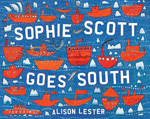 Many curious young readers would embrace the experiences nine-year-old Sophie Scott has as she heads south. In the case of Sophie, the author’s alter ego, her trip south takes her to the bottom of the earth on her father's icebreaker. The entire journey, including her sojourn on Antarctica, takes 30 days, and Sophie charts her adventures along the way. She includes almost daily entries describing the ice, the animals the explorers encounter, and the incredible journey. Her enthusiastic ruminations are accompanied by photographs and art from children who followed the author's own trip to Antarctica aboard an ice breaker. Although the diary entries are based on the adult author's actual experiences, having them written by a child adds to the book's appeal as Sophie notices parts of the journey that many adults might have missed. Readers can feel the choppiness of the waves, see the endless ice, be surprised by the colors that surround in a world that is predominantly white, and hear the sounds of the seals as she sails to the ends of the earth and back. The book is a sensory feast for the adventurous.
Many curious young readers would embrace the experiences nine-year-old Sophie Scott has as she heads south. In the case of Sophie, the author’s alter ego, her trip south takes her to the bottom of the earth on her father's icebreaker. The entire journey, including her sojourn on Antarctica, takes 30 days, and Sophie charts her adventures along the way. She includes almost daily entries describing the ice, the animals the explorers encounter, and the incredible journey. Her enthusiastic ruminations are accompanied by photographs and art from children who followed the author's own trip to Antarctica aboard an ice breaker. Although the diary entries are based on the adult author's actual experiences, having them written by a child adds to the book's appeal as Sophie notices parts of the journey that many adults might have missed. Readers can feel the choppiness of the waves, see the endless ice, be surprised by the colors that surround in a world that is predominantly white, and hear the sounds of the seals as she sails to the ends of the earth and back. The book is a sensory feast for the adventurous.
– Barbara A. Ward, Washington State University Pullman
Littlewood, Kathryn. (2013). A dash of magic: a Bliss novel. New York: Katherine Tegen Books/HarperCollins.
 It’s all about the Bliss Cookery Booke as book two in the Bliss series takes off where book one (Bliss, 2012) ended when Rosemary’s (aka Rose’s) evil Aunt Lily Le Fey steals the magical cookbook. In this new volume, Rose and her eccentric family dash off to Paris where Rose has challenged Aunt Lily to a bake-off known as the Gala des Gateaux Grands, and the winner gets the Cookery Booke. The trick is that Rose and her family must find all the magical ingredients to make the special recipes. This leads them on a romp around Paris visiting such world famous sites as the Eiffel Tower, the Palace of Versailles, Notre Dame Cathedral, the Louvre Art Museum, the Catacombs, and more. After the bake-off, conditions are ripe for Book 3.
It’s all about the Bliss Cookery Booke as book two in the Bliss series takes off where book one (Bliss, 2012) ended when Rosemary’s (aka Rose’s) evil Aunt Lily Le Fey steals the magical cookbook. In this new volume, Rose and her eccentric family dash off to Paris where Rose has challenged Aunt Lily to a bake-off known as the Gala des Gateaux Grands, and the winner gets the Cookery Booke. The trick is that Rose and her family must find all the magical ingredients to make the special recipes. This leads them on a romp around Paris visiting such world famous sites as the Eiffel Tower, the Palace of Versailles, Notre Dame Cathedral, the Louvre Art Museum, the Catacombs, and more. After the bake-off, conditions are ripe for Book 3.
– Karen Hildebrand, Ohio Library and Reading Consultant
Randall, Ronne. (2013). Thanksgiving sweets and treats. New York: Windmill Books/Rosen Publishing.
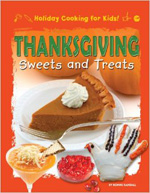 Use this photo-friendly, step-by-step recipe instructional cookbook to make young hands into helpful hands to assist with the Thanksgiving dinner preparations. All of these easy to make recipes come with directions that are easy to follow and understand. A few of the treats included are: Pumpkin pie, turkey salad mini rolls, turkey noodle soup, apple-honey cranberry sauce, super simple succotash, and more.
Use this photo-friendly, step-by-step recipe instructional cookbook to make young hands into helpful hands to assist with the Thanksgiving dinner preparations. All of these easy to make recipes come with directions that are easy to follow and understand. A few of the treats included are: Pumpkin pie, turkey salad mini rolls, turkey noodle soup, apple-honey cranberry sauce, super simple succotash, and more.
If you don’t want this help in the kitchen before the meal, these recipes will work for leftovers, too!
– Karen Hildebrand, Ohio Library and Reading Consultant
Yolen, Jane. (2013). Jewish fairy tale feasts; a literary cookbook. Recipes by Heidi E.Y. Stemple; Illus. by Sima Elizabeth Shefrin. North Hampton, MA: Crocodile Books, USA.
 From the mother and daughter duo that brought young readers Fairy Tale Feasts in 2006, they are back to celebrate recipes and stories from the Jewish culture. The book includes 18 recipes and stories that span the globe of Jewish tales from Eastern Europe, Morocco, the Middle East and more. Blintzes, chicken soup, matzo balls, bagels, challah, potato pancakes, kugel, rugalach, tzimmes, hamantaschen are but a few of the delectable treats included. Storyteller Jane Yolen discusses the background for the book on her blog and talks about her daughter’s collection of cookbooks and how much they enjoyed bringing out the recipes of grandmothers and great aunts and friends to put into this collection. Heidi also made lots of samples for Jane and family to taste while the book was in progress in addition to adding detailed notes about both the stories and the recipes. Steeped in family tradition, the stories and food complement each other for a tasty treat for all. Learn more about author Jane Yolen, in this 5 Questions With... interview
From the mother and daughter duo that brought young readers Fairy Tale Feasts in 2006, they are back to celebrate recipes and stories from the Jewish culture. The book includes 18 recipes and stories that span the globe of Jewish tales from Eastern Europe, Morocco, the Middle East and more. Blintzes, chicken soup, matzo balls, bagels, challah, potato pancakes, kugel, rugalach, tzimmes, hamantaschen are but a few of the delectable treats included. Storyteller Jane Yolen discusses the background for the book on her blog and talks about her daughter’s collection of cookbooks and how much they enjoyed bringing out the recipes of grandmothers and great aunts and friends to put into this collection. Heidi also made lots of samples for Jane and family to taste while the book was in progress in addition to adding detailed notes about both the stories and the recipes. Steeped in family tradition, the stories and food complement each other for a tasty treat for all. Learn more about author Jane Yolen, in this 5 Questions With... interview
– Karen Hildebrand, Ohio Library and Reading Consultant
GRADES 8-12
Crane, Caprice. (2013). Confessions of a hater. New York: Macmillan/Feiwel and Friends.
 As sophomore Hailey Harper packs for the family's move across the country to California, she stumbles on her popular older sister's journal and thinks she's found the blueprint for popularity. Filled with beauty, fashion, and behavioral tips, the book prompts Hailey to follow Noel's instructions and wear her cast-offs. Once she arrives in West Hollywood, Noel's advice continues to guide her, and Hailey is befriended by the school's resident Queen Bee, Skyler. But Hailey is too original to tolerate blindly following Skyler. Despite its consequences, she steps away from the popular crowd and gathers together her own group. As battle lines are drawn and Hailey's crew pulls off some hilarious pranks that make her nemesis the object of ridicule, Hailey herself realizes how easily the bullied can become the one who bullies others. Mixed as it is with humor, romance, and insight, this title offers plenty to discuss while serving up a gentle reminder about fidelity to oneself. Although the book’s loose ends are tied up a little too neatly with Hailey escaping harsh punishment for her prankish apology to those she has wronged, this one is required reading.
As sophomore Hailey Harper packs for the family's move across the country to California, she stumbles on her popular older sister's journal and thinks she's found the blueprint for popularity. Filled with beauty, fashion, and behavioral tips, the book prompts Hailey to follow Noel's instructions and wear her cast-offs. Once she arrives in West Hollywood, Noel's advice continues to guide her, and Hailey is befriended by the school's resident Queen Bee, Skyler. But Hailey is too original to tolerate blindly following Skyler. Despite its consequences, she steps away from the popular crowd and gathers together her own group. As battle lines are drawn and Hailey's crew pulls off some hilarious pranks that make her nemesis the object of ridicule, Hailey herself realizes how easily the bullied can become the one who bullies others. Mixed as it is with humor, romance, and insight, this title offers plenty to discuss while serving up a gentle reminder about fidelity to oneself. Although the book’s loose ends are tied up a little too neatly with Hailey escaping harsh punishment for her prankish apology to those she has wronged, this one is required reading.
– Barbara A. Ward, Washington State University Pullman
Murdock, Catherine Gilbert. (2013). Heaven is paved with Oreos. Boston: Houghton Mifflin Harcourt.
 Fourteen-year-old Sarah Zorn and her best friend Curtis have managed to thwart all the gossips at their high school by pretending to date one another. They share a fondness for science, honed through several science projects, and a taste for the simple things in life. Curtis loves chocolate ice cream, and Sarah prefers vanilla. But chats with D. J. Schwenk, star athlete and Curtis’s big sister, featured in the author’s earlier Dairy Queen (Houghton Mifflin Harcourt, 2006), The Off Season (Houghton Mifflin Harcourt, 2007), and Front and Center (Houghton Mifflin Harcourt, 2009), heighten Sarah’s awareness about the possible romantic feelings between the two of them. When Sarah’s eccentric grandmother, Z, plans a trip to Rome with Sarah, she seizes the chance to avoid dealing with Curtis while possibly tasting all the pleasures Italy has to offer. Since Sarah hasn’t been very far from her small town Wisconsin home, she isn’t even sure that she will like the pizza certain to be served at every restaurant in Rome. As Z reveals her own secrets from the past, Sarah comes to know her own heart’s desires and the need for treats such as cream-filled Oreos. This is a satisfying treat featuring two likeable characters from the earlier books amid a Beatles-filled reminder not to hide your love away.
Fourteen-year-old Sarah Zorn and her best friend Curtis have managed to thwart all the gossips at their high school by pretending to date one another. They share a fondness for science, honed through several science projects, and a taste for the simple things in life. Curtis loves chocolate ice cream, and Sarah prefers vanilla. But chats with D. J. Schwenk, star athlete and Curtis’s big sister, featured in the author’s earlier Dairy Queen (Houghton Mifflin Harcourt, 2006), The Off Season (Houghton Mifflin Harcourt, 2007), and Front and Center (Houghton Mifflin Harcourt, 2009), heighten Sarah’s awareness about the possible romantic feelings between the two of them. When Sarah’s eccentric grandmother, Z, plans a trip to Rome with Sarah, she seizes the chance to avoid dealing with Curtis while possibly tasting all the pleasures Italy has to offer. Since Sarah hasn’t been very far from her small town Wisconsin home, she isn’t even sure that she will like the pizza certain to be served at every restaurant in Rome. As Z reveals her own secrets from the past, Sarah comes to know her own heart’s desires and the need for treats such as cream-filled Oreos. This is a satisfying treat featuring two likeable characters from the earlier books amid a Beatles-filled reminder not to hide your love away.
– Barbara A. Ward, Washington State University Pullman
These reviews are submitted by members of the International Reading Association's Children's Literature and Reading Special Interest Group (CL/R SIG) and are published weekly on Reading Today Online. The International Reading Association partners with the National Council of Teachers of English and Verizon Thinkfinity to produce ReadWriteThink.org, a website devoted to providing literacy instruction and interactive resources for grades K–12.